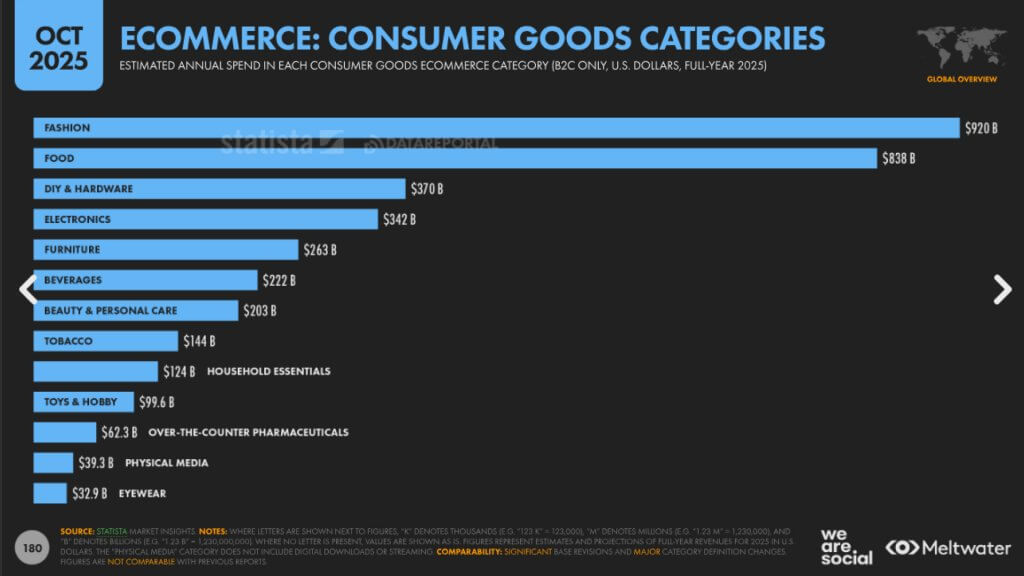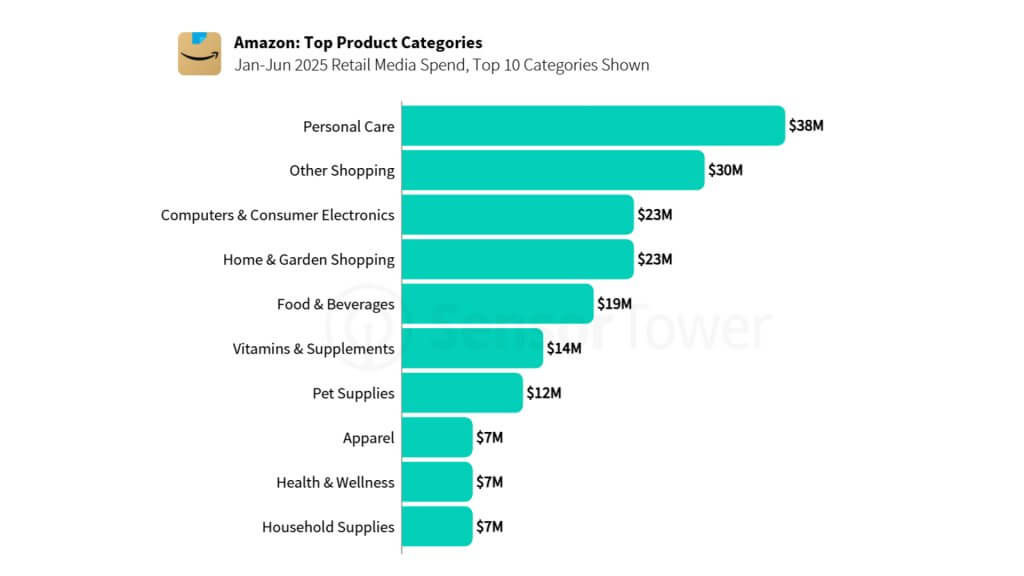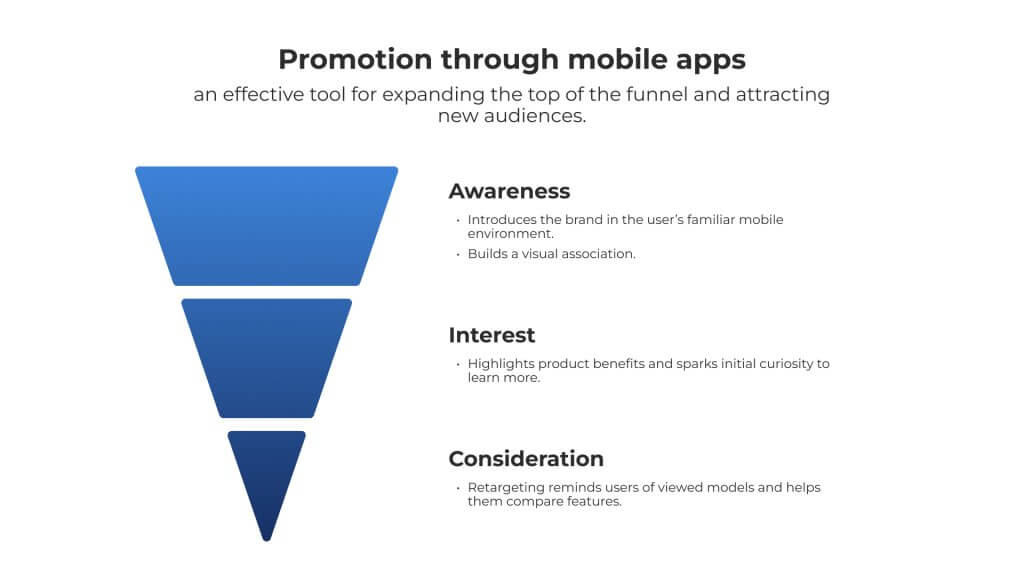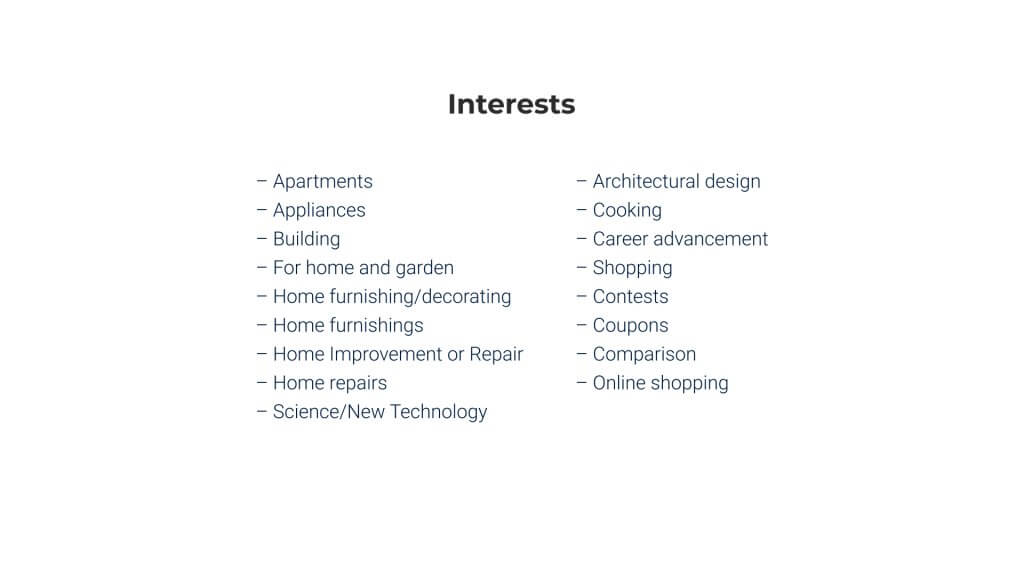In-App in Electronics: How Mobile Advertising Drives Brand Growth
In-app advertising in the electronics sector is becoming one of the key drivers of sales growth and brand recognition. Mobile ads within apps enable electronics manufacturers and retailers to:
- Target their audiences more precisely
- Encourage repeat purchases
- Promote new devices at moments of peak user interest
In this article, we explore how the global electronics market is evolving, which tools brands are using, and which in-app formats deliver the highest performance.
Electronics in 2025: Global Statistics
According to DataReportal, global e-commerce spending on electronics in 2025 is projected to reach $342 billion, ranking fourth among all online consumer goods categories.
According to a study by Grand View Research, the global e-commerce electronics market is projected to reach $856.4 billion by 2028. In Europe, the “Electronics” category accounts for around 11% of all online retail sales.
Computers and electronics are among the top product categories on Amazon, with total spending in this segment reaching $23 million.
The popularity of smart devices continues to grow. Statistics show that the share of internet users who own smartwatches increased from 27.1% in 2024 to 27.8% in 2025.
E-commerce is becoming a key channel for electronics sales. In many developed markets, nearly half or more of all electronics purchases now take place online.
Brands need to recognize that the share of online sales continues to grow, and marketing strategies must be adapted to the digital environment — including targeting, mobile apps, in-app formats, and marketplaces.
In Europe, the online growth dynamic is strong, but absolute figures remain lower than in the United States. In the U.S., the online share is already high, so further growth will come primarily from improved efficiency, better services, and innovative formats.
Popular Marketing Channels for Promoting Electronics
Let’s look at the most common advertising tools:
- Influencer marketing remains one of the most effective ways to promote electronics. Brands actively collaborate with bloggers and tech experts whose reviews and recommendations build trust and drive sales. The main advantage is the high level of audience engagement and strong impact on the device selection stage.
- Content marketing is evolving toward practical formats: articles, video tutorials, and model comparisons help consumers make informed decisions. Companies use their own media and social platforms to showcase product advantages indirectly — through expert and educational content.
- Personalized email and push notifications help retain customers after purchase and encourage additional spending — on accessories, warranty programs, and device upgrades.
- Marketplaces and SEO promotion continue to play a key role: users often begin their search on marketplaces, making it essential to optimize product pages, reviews, and special offers.
- In-app advertising is becoming a new marketing channel for electronics brands. It allows products to be promoted directly within mobile applications where users already show interest in technology. This format ensures precise targeting, a high CTR, and direct influence on purchase decisions.
How In-App Advertising Influences the Consumer Journey in the Electronics Segment
Today, electronics are more than just products — they are an integral part of a digital lifestyle. That’s why mobile advertising has become a key communication channel: it allows brands to reach consumers at the moment of decision-making, build loyalty, and stimulate sales.
In-app advertising strengthens brand marketing strategies. Promotion through mobile applications is an effective way to expand the top of the funnel and attract new audiences.
What In-App Advertising Impacts
Awareness
Introduces the brand in the user’s familiar mobile environment. Creates visual associations and increases spontaneous brand recall during future electronics searches.
Interest
Showcases product features and benefits interactively (360-degree views, usage scenarios).
Generates initial curiosity and encourages users to click through to product pages or landing sites.
Enables more precise audience targeting by interest group (gamers, photographers, smart-home users, etc.).
Consideration
Retargeting reminds users of previously viewed models and helps them compare features. Customer reviews and promotions build trust and influence purchase decisions.
BYYD Mobile Platform Capabilities
Programmatic buying is an automated process of purchasing advertising through DSP platforms in real time (RTB). A brand signs a single contract with the BYYD platform, which handles all interactions with SSPs and publishers. This approach simplifies paperwork and ensures centralized control over all ad placements.
In contrast, with direct buying, a brand has to sign multiple agreements with individual publishers, significantly increasing the workload for legal and accounting departments.
Targeting Features in Programmatic
In-app advertising in the electronics segment enables brands to reach their target audience through various types of targeting, including:
- Socio-demographic parameters (gender, age, income level, education, etc.)
- Geolocation (+Super Geo targeting)
- User behavior (relevant interests, installed apps)
- Device types by mobile operator, manufacturer, operating system, and more
For example, to promote the new open Electrolux’s store in Ankara and Bursa BYYD configured targeting based on interests such as apartments, appliances, building, for home and garden, home furnishing/decorating, home furnishings.
Daily Campaign Optimization: Black List and White List
Continuous monitoring of campaign performance allows BYYD’s mobile specialists to manage traffic quality in real time using both BYYD platform data and Yandex Metrica analytics.
- Black List: excludes apps and publishers with low engagement rates, high lead costs, or suspicious activity. This helps reduce inefficient spending and improve targeting accuracy.
- White List: includes verified, high-performing apps and publishers that deliver quality impressions and high CTR.
Daily optimization based on these lists supports steady growth in campaign performance and ROI.
In-app Formats Increase Engagement and Brand Recall
In the electronics category, in-app advertising drives stronger brand recall and consumer loyalty. Through creative formats — from video banners to interactive Rich Media ads with gamified mechanics — BYYD captures user attention and increases engagement.
Compared to web browsing, users experience less “ad noise” in mobile environments, which enhances ad performance.
Examples of banners for brands in the electronics segment:
Brand Safety Approach
To ensure secure and reliable placements, BYYD applies a comprehensive Brand Safety strategy that includes:
- Multi-level verification of all advertising inventory;
- Traffic quality evaluation via third-party tracking tools;
- Creation of dynamic White and Black lists;
- Participation in auctions only through verified devices.
Brand Lift: Measuring the Impact of Mobile Advertising
BYYD conducts Brand Lift studies to measure how mobile advertising influences brand perception and key marketing metrics — awareness, interest, and purchase intent.
The methodology is based on comparing responses from two groups: users who have seen the ad (test group) and those who haven’t (control group). The difference in results reveals the real impact of the campaign.
Brand Lift goes beyond traditional metrics like CTR or reach, providing insight into the branding effect of mobile campaigns. The results help optimize creatives, media planning, and targeting for future launches.
For example, during the Karcher campaign, the Brand Lift study revealed that 42% of users who hadn’t seen the BYYD ads were unaware of the brand, while 47% of those who had seen the ads recognized it.
In 2025, in-app advertising in the electronics segment plays a vital role. Mobile ads reach audiences that are both interested in innovation and financially ready to purchase, addressing one of the main brand objectives — to attract attention and stay top of mind.
To learn more about in-app opportunities and explore BYYD’s case studies, visit the official website.
For consultations and partnership inquiries:
- Submit a request on our website
- Email us at hello@byyd.me







